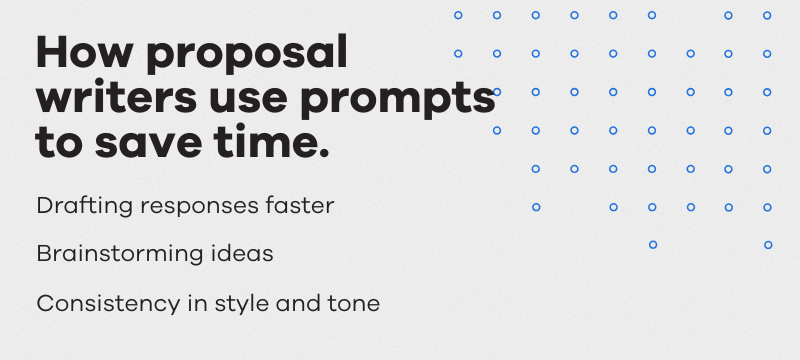Generative AI is making work easier for all types of proposal writers. Using automatic response generation, proposal writers can quickly craft responses, create new content, and update existing content to fit each unique opportunity better.
However, when first using generative AI, many proposal writers ask a simple question: what should I ask the model to get the responses I want? While it might initially seem simple, generative AI experts know that prompting is a fine art. Understanding what questions to ask, how to phrase each request or suggestion, and how to combine requests are all valuable skills that improve any generative AI workflow.
The secret to success? Understanding and investing in valuable prompt techniques. By learning just a few techniques, you’ll improve your accuracy and decrease the number of additional tweaks and edits needed after each newly generated response.
What Are Generative AI Prompts?
Generative AI prompts are statements or questions you provide to an AI system to generate a relevant response. Simply put, they’re instructions or cues that tell the AI what type of information, tone, or format you’d like the output to have. Prompts are the starting point for your writing, the better the prompt you use, the better the AI’s response.
Here’s an example:
- A simple prompt might be: “Rewrite this mission statement.”
- A detailed prompt might be: “Rewrite this mission statement to be one paragraph long, emphasizing the professionalism and years of expertise our company has.”
What are prompt techniques?
Prompt techniques are strategies or methods to guide generative AI models and help them produce your desired result faster. Or, put another way, it’s how you, as a human, communicate with the AI model and give it the instructions it needs to produce a clear, well-written response.
While most generative AI models are designed to be conversational and easy to use, it can often take some fine-tuning to get results that work for your specific needs. Learning different prompt techniques can help you get work done faster, saving valuable time when writing your next proposal.
There are many different prompt techniques out there, and it’s likely that as you continue adding generative AI to your workflow, you’ll find yourself using a wide variety of them. To get you started, we wanted to provide some tried-and-true strategies for crafting effective AI prompts. These examples were hand-picked by our team of specialists to fit the specific needs of proposal writers, helping them save time while producing clear, concise, and accurate results.
Some types of prompt techniques include:
- Role-based prompts
Assign a specific role or perspective to generate a response. - Scenario-based prompts
Describe a situation to generate a response. - Question and answer prompts
Ask an open-ended question to generate a response. - Instructional prompts
Limit responses based on constraints like word count, perspective, and specific keywords. - Comparative prompts
Ask for a comparison between two ideas. - Chained prompts
Chain together several prompts for a complex response.
How proposal writers use prompts to save time

Drafting responses faster
Perhaps the most obvious answer is that proposal writers can quickly generate responses and rewrite existing content to use in their proposals by using prompts. Additionally, using software like Qvidian that allows users to save and share prompts with team members, you can easily reuse prompts for multiple proposals.
Consistency in style and tone
Some prompts can be used to help keep all your generated responses or even your existing content consistent in style and tone. While we already recommend that professionals only pull from the approved content in their content library to increase the chances that everything included in their final proposal is on brand, sometimes content pieces need additional rewrites, tweaks, or adjustments.
A simple prompt like “Adjust this paragraph to remove all contractions” or “Rewrite this paragraph in British English” can ensure that all pieces of content fit the same brand standards you’ve identified.
Brainstorming Ideas
Many professionals choose to use open-ended prompts or comparison prompt techniques to help them brainstorm initial ideas. While you might not know what you want to write about specifically, asking open-ended questions can spark new ideas, help you formulate an outline, or provide key insights from an instructional document that can help jumpstart your writing.
Using prompts helps teams save time and win more.
Using Generative AI Prompts might sound like a simple concept. Still, as the technology behind artificial intelligence continues to grow, proposal writers will need to practice and learn how to refine every prompt they enter.
By learning the techniques and experimenting with new and creative prompts, your team can streamline your proposal process while maintaining consistency. Whether you’re drafting the final piece of content for a major customer or refining a complex technical document to be easily understood, generative AI prompts can help you save time.
Want to explore the power of prompts even further? Check out our instructor-led course, Crafting Effective AI Prompts for Proposal Writers. In this course, our experts break down the crucial prompt techniques proposal writers need to win more deals.
